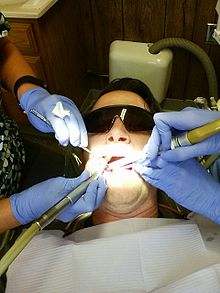Dentist
A dentist, also known as a dental surgeon, is a surgeon who specializes in dentistry, the diagnosis, prevention, and treatment of diseases and conditions of the oral cavity. The dentist’s supporting team aids in providing oral health services. The dental team includes dental assistants, dental hygienists, dental technicians, and in some states, dental therapists.
Modern dentistry
Pierre Fauchard of France is often referred to as the “father of modern dentistry” for being the first to publish a scientific textbook (1728) on the techniques and practices of dentistry.[3] Over time, trained dentists immigrated from Europe to the Americas to practice dentistry, and by 1760, America had its own native born practicing dentists. Newspapers were used at the time to advertise and promote dental services. In America from 1768–1770 the first application of dentistry to verify forensic cases was being pioneered; this was called forensic dentistry. With the rise of dentists there was also the rise of new methods to improve the quality of dentistry. These new methods included the spinning wheel to rotate a drill and chairs made specifically for dental patients.[4]
In the 1840s the world’s first dental school and national dental organization were established. Along with the first dental school came the establishment of the Doctor of Dental Surgery degree, often referred to as a DDS degree. In response to the rise in new dentists as well as dentistry techniques, the first dental practice act was established to regulate dentistry. In the United States, the First Dental Practice Act required dentists to pass each specific states medical board exam in order to practice dentistry in that particular state. However, because the dental act was rarely enforced, some dentists did not obey the act. From 1846–1855 new dental techniques were being invented such as the use of ester anesthesia for surgery, and the cohesive gold foil method which enabled gold to be applied to a cavity. The American Dental Association was established in 1859 after a meeting with 26 dentists. Around 1867, the first university associated dental school was established, Harvard Dental School. Lucy Hobbs Taylor was the first woman to earn a dental degree. In the 1880s, tube toothpaste was created which replaced the original forms of powder or liquid toothpaste. New dental boards, such as the National Association of Dental Examiners, were created to establish standards and uniformity among dentists.[4] In 1887 the first dental laboratory was established; dental laboratories are used to create dentures and crowns that are specific to each patient.[5] In 1895 the dental X-ray was discovered by a German physicist, Wilhelm Röntgen.[6]
In the 20th century new dental techniques and technology were invented such as: the porcelain crowns (1903), Novocain (a local anesthetic) 1905, precision cast fillings (1907), nylon toothbrushes (1938), water fluoridation (1945), fluoride toothpaste (1950), air driven dental tools (1957), lasers (1960), electric toothbrushes (1960), and home tooth bleaching kits (1989) were invented. Inventions such as the air driven dental tools ushered in a new high-speed dentistry.[4][4][7]
Responsibilities
By nature of their general training, a licensed dentist can carry out most dental treatments such as restorative (dental restorations, crowns, bridges), orthodontics (braces), prosthodontic (dentures, crown/bridge), endodontic (root canal) therapy, periodontal (gum) therapy, and oral surgery (extraction of teeth), as well as performing examinations, taking radiographs (x-rays) and diagnosis. Additionally, dentists can further engage in oral surgery procedures such as dental implant placement. Dentists can also prescribe medications such as antibiotics, fluorides, pain killers, local anesthetics, sedatives/hypnotics and any other medications that serve in the treatment of the various conditions that arise in the head and neck.
All DDS and DMD degree holders are legally qualified to perform a number of more complex procedures such as gingival grafts, bone grafting, sinus lifts, and implants, as well as a range of more invasive oral and maxillofacial surgery procedures, though many choose to pursue residencies or other post-doctoral education to augment their abilities. A few select procedures, such as the administration of General anesthesia, legally require postdoctoral training in the US. While many oral diseases are unique and self-limiting, poor conditions in the oral cavity can lead to poor general health and vice versa; notably, there is a significant link between periodontal and cardiovascular disease.[8] Conditions in the oral cavity may also be indicative of other systemic diseases such as osteoporosis, diabetes, AIDS, and various blood diseases, including malignancies and lymphoma.
Several studies have suggested that dentists and dental students are at high risk of burnout. During burnout, dentists experience exhaustion, alienate from work and perform less efficiently.[9] A systemic study identified risk factors associated with this condition such as practitioner’s young age, personality type, gender, status of education, high job strain and / or working hours, and the burden of clinical degrees requisites. The authors of this study concluded that intervention programs at an early stage during the undergraduate level may provide practitioners with a good strategy to prepare for / cope with this condition.[10]
Burnet
Burnet (/ˈbɜːrnᵻt/ bur-nit) is a city in and the county seat of Burnet County, Texas, United States.[3] The population was 5,987 at the 2010 census.[4]
Both the city and the county were named for David Gouverneur Burnet, the first (provisional) president of the Republic of Texas. He also served as Vice President during the administration of Mirabeau B. Lamar.
Burnet is located one mile west of the divide between the Brazos and Colorado River watersheds near the center of Burnet County. It is 54 miles (87 km) northwest of the state capital, Austin – roughly a 1- to 1½-hour drive via U.S. Highway 183 and State Highway 29. It is 36 miles (58 km) west of Georgetown and Interstate Highway 35 via State Highway 29, and 100 miles (160 km) north of San Antonio on U.S. Highway 281.
According to the United States Census Bureau, Burnet has a total area of 10.2 square miles (26.3 km2), of which 10.1 square miles (26.2 km2) is land and 0.04 square miles (0.1 km2), or 0.32%, is water.[4]

